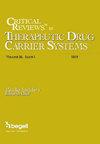Inhalational Drug Delivery in Pulmonary Aspergillosis.
IF 3
4区 医学
Q2 PHARMACOLOGY & PHARMACY
Critical Reviews in Therapeutic Drug Carrier Systems
Pub Date : 2019-01-01
DOI:10.1615/CRITREVTHERDRUGCARRIERSYST.2018025781
引用次数: 9
Abstract
Pulmonary infections have long represented one of the major threats to humans. These vary from acute to chronic conditions, depending upon the underlying disease of the airways. Pulmonary aspergillosis (PMAP) has raised vital concerns in the immunocompromised patients. The fungal infection is difficult to diagnose in the early stages, often making the disease more complicated. Currently, three classes of antifungal agents are available on the market for the treatment of pulmonary infections. These agents are available in oral and intravenous forms only, which limits the availability of therapeutic concentrations of drug in the lungs for longer durations. Consequently, this leads to therapeutic failure and/or resistance of the organism(s) towards the antifungal agents because the optimum amount of drug does not reach the infection site. To combat the issues associated with the conventional regimens, inhalation of antifungal agents is gaining importance because administration to the lungs offers huge advantages of localized and targeted delivery. A wide range of inhalational devices such as nebulizers, dry powder inhalers, and metered dose inhalers are available on the market to deliver drug molecules to the lungs effectively. However, their clinical utility is limited to conditions such as asthma, chronic obstructive pulmonary disease, and cystic fibrosis only. For a few decades, inhalation therapy has also been gaining importance to treat infectious diseases such as tuberculosis and aspergillosis, though more research efforts are required to make the transition from bench to bedside. The current review provides an explicit account of the potential role of inhalation drug delivery in PMAP.肺曲霉病的吸入给药。
长期以来,肺部感染一直是人类面临的主要威胁之一。根据气道的潜在疾病,这些情况从急性到慢性各不相同。肺曲霉病(PMAP)引起了免疫功能低下患者的严重关注。真菌感染在早期阶段很难诊断,往往使疾病更加复杂。目前,市场上有三种抗真菌药物可用于治疗肺部感染。这些药物仅以口服和静脉注射形式提供,这限制了治疗浓度药物在肺部较长时间的可用性。因此,这会导致治疗失败和/或生物体对抗真菌药物产生耐药性,因为最佳剂量的药物没有到达感染部位。为了解决与传统治疗方案相关的问题,吸入抗真菌药物变得越来越重要,因为给药到肺部提供了局部和靶向递送的巨大优势。市场上有各种吸入装置,如雾化器、干粉吸入器和计量吸入器,可将药物分子有效地输送到肺部。然而,它们的临床应用仅限于哮喘、慢性阻塞性肺疾病和囊性纤维化等疾病。几十年来,吸入疗法在治疗肺结核和曲霉病等传染病方面也越来越重要,尽管需要更多的研究努力才能从实验室过渡到临床。目前的综述提供了吸入给药在PMAP中的潜在作用的明确说明。
本文章由计算机程序翻译,如有差异,请以英文原文为准。
求助全文
约1分钟内获得全文
求助全文
来源期刊
CiteScore
5.50
自引率
18.50%
发文量
27
审稿时长
>12 weeks
期刊介绍:
Therapeutic uses of a variety of drug carrier systems have significant impact on the treatment and potential cure of many chronic diseases, including cancer, diabetes mellitus, psoriasis, parkinsons, Alzheimer, rheumatoid arthritis, HIV infection, infectious diseases, asthma, and drug addiction. Scientific efforts in these areas are multidisciplinary, involving the physical, biological, medical, pharmaceutical, biological materials, and engineering fields.
Articles concerning this field appear in a wide variety of journals. With the vast increase in the number of articles and the tendency to fragment science, it becomes increasingly difficult to keep abreast of the literature and to sort out and evaluate the importance and reliability of the data, especially when proprietary considerations are involved. Abstracts and noncritical articles often do not provide a sufficiently reliable basis for proper assessment of a given field without the additional perusal of the original literature. This journal bridges this gap by publishing authoritative, objective, comprehensive multidisciplinary critical review papers with emphasis on formulation and delivery systems. Both invited and contributed articles are subject to peer review.

 求助内容:
求助内容: 应助结果提醒方式:
应助结果提醒方式:


